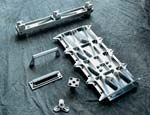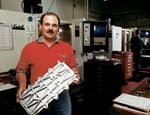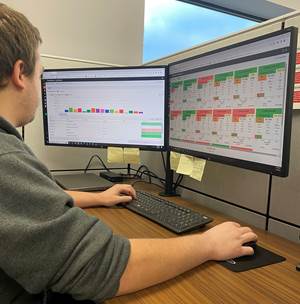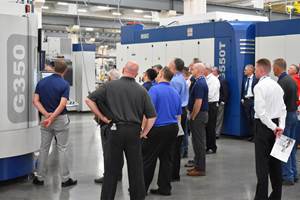Machine Tool Coolant Racing To Save Time And Improve Quality
As a former racecar driver, Jon Horgas is well aware that raw horsepower alone does not guarantee victory, and the fastest car does not always finish first. It takes a combination of finely tuned aerodynamics and suspension, fuel mixtures and gear ratios, driver skills and experience, a top-notch pit crew, tire composition, high quality components, and luck.
Share


Hwacheon Machinery America, Inc.
Featured Content
View More





As a former racecar driver, Jon Horgas is well aware that raw horsepower alone does not guarantee victory, and the fastest car does not always finish first. It takes a combination of finely tuned aerodynamics and suspension, fuel mixtures and gear ratios, driver skills and experience, a top-notch pit crew, tire composition, high quality components, and luck.
As owner and president of Tru-Bore Machine Tool Company (Westland, Michigan), Mr. Horgas is well aware that raw horsepower alone does not guarantee faster machining times, and a high speed spindle does not finish parts first. It takes a combination of machine accuracy, workholding and toolholder rigidity, tool material and geometry, setup personnel and operator skills, plus chip handling capabilities of the system. A little luck can pay off as well. And, as Mr. Horgas has recently discovered, the proper coolant selection has had a significant role in the success of his high speed machining operations, providing much faster machining times, better dimensional accuracy and improved surface finishes.
Mr. Horgas stopped racing and started Tru-Bore in 1987, with a primary business being the machining and assembling of articulated arms for mounting digital readouts to knee mills. But his passion for the racing circuit drew him back in, and Tru-Bore soon was producing racing related products from a variety of aluminum alloys in addition to the DRO mounting arms. Under the name of Precision Motorsports, the company manufactures and markets fuel system components and precision alignment platforms with their associated tools used by Indy Race League and CART teams, Formula cars and Trans-Am Series teams. Precision Motorsports is an official supplier to the Barber Dodge Pro Series race circuit. The company also manufactures its own line of machined aluminum racing wheels.
"Don't be misled by the name ‘alignment' platform," explains Mr. Horgas, "because what the mechanics perform for the race cars is much more than just measuring and setting wheel alignment as with a passenger car. Before each and every run, race or practice, the car's chassis must be precisely calibrated as to its four corners. Depending on track conditions and ambient atmospheric conditions, the suspension at each wheel can be fined tuned to provide optimum handling characteristics, minimizing under- or over-steering tendencies. Our platforms provide the consistent and repeatable precision mechanics need to accurately calibrate corner weights, thus achieving top speeds while maintaining the highest level of handling and driver safety. Considering that sticker price for one of these racers is well in excess of $1 million, even the slightest bump against a wall can be devastating. It's critical that the car handle correctly."
It is in the machining of one of the components for the alignment platform that coolant created by Argent Limited made the big difference. The part is the main support bed, made from a solid billet of 6061-T6511 aluminum alloy measuring 21 ½ inches long by 10 ¾ inches wide by 1 ½ inches deep. To minimize weight (the units are portable and are shipped all over the world by teams to various race locations) without compromising strength, nearly 30 pockets are milled on the two large faces, leaving a web-like pattern. Each pocket is approximately ¾ inch deep. Other machining involves milling triangular mounting points on the two long sides, a tenon on each short side, plus drilling holes for assembly.
Before using the Argent coolant, the machining operation for this piece was performed on a Fadal VMC and included two rough cuts using a 3/8-inch diameter solid carbide end mill, at approximately 3/8 inch deep each, and then a finish pass. To run any faster or at greater removal rates typically caused a build up of chips on the end mill that led to galling, excessive tool wear and eventually tool breakage. Two different brands of cutting fluid were tested, with similar results and similar machining times of 2 1/4 hours.
That's when Mr. Horgas contacted Argent. "We need to manufacture the alignment platform at a reasonable cost yet still be profitable," he notes. "To do that, we have to push the tools and achieve maximum efficiency of the machine tool. The other coolants were preventing us from reaching that goal."
According to Mr. Horgas, the difference between Argent and the "other guys" was the fact that Argent personnel analyzed his application and provided a special formula dictated by the application's characteristics. "They didn't just ship in a barrel of some stock coolant," he reports. "The lubricity and viscosity are a perfect match for our parts, materials and tools . . . the tools last almost forever with no chip buildup. In fact, the metal removal rate is so intense that we had to install secondary screens to keep chips from flying out of the machine."
And the only change in the operation, except for increased speeds and feeds, was the coolant. "Actually, it sounds too good to be true," Mr. Horgas says, "that a change of coolant, with no other alterations in our operation, could make such a difference, but we've done it. We've slashed our machining time. We're running the machine's spindle at its top-end rpm, we've increased our initial rough cut feed rate by 20 percent, eliminated a secondary rough cut altogether, enhanced dimensional accuracy by reducing heat distortion, improved part surface finish, and, as an added bonus, eliminated part discoloration caused by coolant interaction with the workpiece material. We were lucky to find the right coolant," he concludes.
Related Content
Machine Monitoring Boosts Aerospace Manufacturer's Utilization
Once it had a bird’s eye view of various data points across its shops, this aerospace manufacturer raised its utilization by 27% in nine months.
Read MoreThe Role of Surface Finishing in Modern Manufacturing: Trends and Best Practices
You’re attending IMTS to advance your business. Regardless of your role in the manufacturing process, considering how your parts will be finished is crucial. This article can help you understand trends in surface finishing and better communicate with your finishing partners.
Read MoreSandvik Coromant Inserts Provide Stable Turning of Aerospace Components
The new insert grades GC1205 and GC1210 cover a large application area within last-stage machining and intermediate-stage machining when turning aerospace engine components.
Read MoreGrob Systems Inc. to Host Tech Event With Industry Partners
The 5-Axis Live technology event will highlight new machining strategies for optimizing the production of complex medical, aerospace and mold/die parts.
Read MoreRead Next
Registration Now Open for the Precision Machining Technology Show (PMTS) 2025
The precision machining industry’s premier event returns to Cleveland, OH, April 1-3.
Read More5 Rules of Thumb for Buying CNC Machine Tools
Use these tips to carefully plan your machine tool purchases and to avoid regretting your decision later.
Read MoreBuilding Out a Foundation for Student Machinists
Autodesk and Haas have teamed up to produce an introductory course for students that covers the basics of CAD, CAM and CNC while providing them with a portfolio part.
Read More

























.png;maxWidth=150)











.jpg;maxWidth=300;quality=90)











